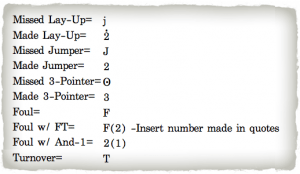 Charting a basketball game can truly be a big difference between winning and losing. If it is a tight game and you are charting it, you will know what offenses and defenses have had the most success. You will know what play to call when you need your absolute best. If you are not charting the game, you are just going off of “gut instinct.” Sure you may remember a play working well earlier. But if you chart the entire game you will be able to see specifically what results you got each time you ran a play, a set, or a defense. Today I will be focusing on how to chart a game offensively.
Charting a basketball game can truly be a big difference between winning and losing. If it is a tight game and you are charting it, you will know what offenses and defenses have had the most success. You will know what play to call when you need your absolute best. If you are not charting the game, you are just going off of “gut instinct.” Sure you may remember a play working well earlier. But if you chart the entire game you will be able to see specifically what results you got each time you ran a play, a set, or a defense. Today I will be focusing on how to chart a game offensively.
First of all, if you are a head coach with a coaching staff at your disposal, you should really have assistants chart the game. This way you can focus on coaching and managing the game. In a perfect world, you would have one assistant doing an offensive chart and one doing a defensive chart. If you only have one assistant, he would do both. It is a little more difficult but not impossible to chart both ends at the same time.
Offensively, you need to keep track of your main sets/plays and the results you get from them. You also need to chart your sideline-out-of-bounds (SLOB) and baseline-out-of-bounds (BLOB) plays. I have the play name on the sheet and have a 1st, 2nd, 3rd, 4th, etc. next to the play. When your team runs the play, mark whatever result occurred. You can refer to the key attached in the article but I will walk you through the specific examples.
If your teams misses a layup, write a lowercase j by it. If your team makes a layup, write a 2 with a dot over it. A missed jumper gets a capital J. A made jumper gets a 2. A missed three pointer gets an O with a dot in it. A made three pointer gets a 3. If you drew a foul, mark an F. If you were fouled in the act of shooting, mark an F with the number of free throws in parentheses, like F(2). A foul with an “and 1” made basket would be marked, 2 (1). A turnover gets a T.
Once you have charted the game you can now start making adjustments by analyzing the results. Half time is obviously a great time to see what worked and what didn’t. Also, a full timeout might be a good time to quickly conference with your assistants to see what your best option is. If you have turned the ball over three times and you need to grind a possession out, you probably would ignore that play. If you got a couple of layups off of a particular play and you need a basket, you would think about running it.
Besides offensive possession, I would also recommend charting offensive rebounds. That way you can see if your team is getting any second shots. I would also probably chart the plus/minus of points for each quarter, so that you can see what combinations of players had success and vice versa.
Charting your offensive game will lead to more success for your offense. You will be able to know how your team is doing with man offense, zone offense, SLOBs, and BLOBs. If you are charting your offense and your opponent is not then you just gave yourself a big advantage. Stay tuned for Defensive game chart tips, coming soon.


